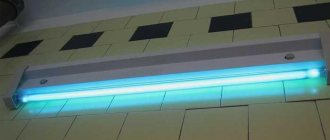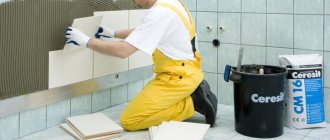Classification of premises according to the degree of danger of electric shock
> Electrical safety > Classification of premises according to the degree of danger of electric shock
The safety of working with electrical installations depends on many things. The most important factor is the working conditions. The quality of work and human safety conditions are negatively affected by the presence of various types of impurities in the atmosphere: dust, gases, excess moisture. High temperatures also degrade the quality of work (in workshops, etc.).
There is a danger of electric shock
All production workshops, premises in which electrical installations are present, according to the degree of danger of electric shock, are divided into groups: group 1 (workshops without increased danger), group 2 (premises with increased danger) and group 3 (particularly dangerous premises).
Classification of objects according to the degree of electrical safety
Even the most reliable insulation loses its properties during prolonged use in harsh conditions. The risk of electric shock increases several times if a person is in a room with a metal floor or works on equipment that is located near metal objects.
According to paragraph 1.1.13 of the rules for the construction of electrical installations (PUE), domestic and commercial premises are divided into three separate classes, which characterize the degree of danger.
"Premises without danger"
This category includes rooms that are characterized by low air humidity (up to 75%), equipped, if necessary, with a ventilation system and heating.
In addition, floors in such rooms must be non-conductive. The term conductive floors means reinforced concrete, metal, earthen, etc. To classify a production workshop as safe, its floor must be covered with dielectric material.
Premises without high danger are workshops in which there is no dampness, high temperature, chemical environment, conductive dust and floors.
Among the safe objects are office and residential buildings, storage rooms intended for storing tools, and laboratories.
"Objects with increased danger"
This classification of objects determines an object to the category of increased danger in the presence of such conditions as:
- The appearance of conductive dust;
- Dampness (if the room humidity is more than 75%);
- High temperature (if the room temperature constantly exceeds 350 degrees);
- Conditions under which a person can simultaneously touch the metal casings of the equipment and the metal structures of the building (an example is the case when a person can simultaneously take hold of a heating radiator, and another person - a machine tool.
Standards for the level of temperature and air humidity for rooms with increased danger are clearly stated in paragraph 1.1.8 and paragraph 1.1.10 of the PUE. This class of premises includes heated mechanical workshops, electrical repair shops, etc.
"Particularly dangerous objects"
This classification includes rooms with high humidity, concentrated suspension of chemicals in the air, as well as at least two factors from the category of high-risk rooms. Conditions required for a room to be included in this group:
- Objects with high dampness (humidity close to 100%);
- Several conditions that are typical for “high-risk objects”;
- Premises in which there is an organic environment and increased chemical activity.
How to achieve safety in electrical premises
Household and industrial electrical equipment surrounds people everywhere. It is present in factory floors, on construction sites, in the offices of various companies and, of course, at home.
If at home a person uses relatively safe household electrical appliances, then at work he has to deal with conditions of increased danger when operating electrical equipment.
Personnel working at industrial facilities must have an idea of which rooms are classified as electrical rooms and what requirements are imposed on personnel when working in them.
To perform their job duties in electrical premises, personnel must have a good knowledge of safety precautions and undergo qualified certification in knowledge of the rules and labor protection in existing electrical installations.
After passing the certification, workers involved in production must know which premises are classified as high-risk premises, and what precautions they must take in them. Each employee must be assigned an electrical safety group.
Electrical rooms, depending on surrounding factors, are divided according to the degree of danger of electric shock.
Types of premises according to the degree of electrical hazard
Their classification according to the degree of danger of electric shock is based on the rules for the design of electrical installations. The purpose of this classification is to prevent electric shock to people. According to electrical safety, premises can be of the following classes:
- without increased danger;
- with increased danger;
- with particular danger.
Premises without increased danger are characterized by the absence of factors leading to electric shock to people. These include company offices, warehouses, residential apartments, with the exception of kitchens. In such rooms, air humidity does not exceed 75 percent, air temperature does not exceed 30 degrees Celsius, floors are made of material that does not conduct electric current, there is no source of conductive dust, and there are no electrical installations connected to a common grounding device.
Premises with increased danger may contain one or more threatening factors:
- air temperature can reach more than 30 degrees Celsius;
- ambient humidity is more than 75 percent, up to 100 percent;
- floors that conduct electric current, for example, earthen, reinforced concrete, containing metal parts or sections;
- on surfaces in the room there may be layers of dust that conduct electric current;
- if the area is filled by more than 20 percent with production or auxiliary equipment;
- It is possible that you can touch grounded metal parts with one hand and the body of the electrical installation with the other hand.
If at least one of these conditions is present regarding the danger of electric shock to people, then they are classified as high-risk premises. These include heated electrical repair shops, garages, and workshops.
The most serious category for possible electric shock to people is especially dangerous premises. They may contain the following dangerous factors:
- strong environmental humidity reaching 100 percent;
- the presence of aggressive chemicals in the air that destroy the insulation of live parts of electrical installations;
- premises where there are two or more hazardous factors for premises with increased danger.
Premises with particular danger include industrial acid shops, paint shops, and areas of open switchgears.
Types of premises according to environmental conditions and electrical safety
PUE divides premises into the following types:
- Where the humidity is no more than 60 percent, they are called dry rooms. In terms of the risk of electric shock, they are premises without increased danger. If they do not contain high ambient temperatures, dust and chemically active particles, then they are called normal. Such characteristics exist, for example, in offices or residential apartments, except for kitchens.
- Humid, according to the PUE, are rooms with humidity in the range of 60-75 percent. Such rooms include those in which steam or condensate in small volumes may be present for a short time. In terms of the risk of electric shock, they are high-risk premises. To protect people from electric shock, it is necessary to apply the entire range of protective measures. Such premises include, for example, kitchens of houses and apartments, basements of residential buildings that have heating. Most electrical equipment is designed for use in dry or humid climates.
- Rooms where the humidity is more than 75 percent are called damp, and when the humidity reaches 100 percent, they are called especially damp.
- Those where the temperature is above 35 degrees Celsius are considered hot.
- Some industries produce a lot of dust, which settles and forms dust layers. Such rooms are called dusty. Process dust can be conductive. In this case, settling on wires, cables, and penetrating inside electrical installations, dust worsens the dielectric properties of the insulation. If there are chemically active technological microparticles in the air of the room, then settling on the insulation, they destroy it.
- If, due to operational needs, objects and liquids that support combustion are stored in a room, then they are called fire hazardous.
- During technological production, mixtures may form in the air, which under certain conditions may explode. Premises where such mixtures may occur are called explosive.
Which electrical installations are called closed or internal? answer
Household and industrial electrical equipment surrounds people everywhere. It is present in factory floors, on construction sites, in the offices of various companies and, of course, at home.
If at home a person uses relatively safe household electrical appliances, then at work he has to deal with conditions of increased danger when operating electrical equipment.
Personnel working at industrial facilities must have an idea of which rooms are classified as electrical rooms and what requirements are imposed on personnel when working in them.
To perform their job duties in electrical premises, personnel must have a good knowledge of safety precautions and undergo qualified certification in knowledge of the rules and labor protection in existing electrical installations.
After passing the certification, workers involved in production must know which premises are classified as high-risk premises, and what precautions they must take in them. Each employee must be assigned an electrical safety group.
Electrical rooms, depending on surrounding factors, are divided according to the degree of danger of electric shock.
Types of premises according to the degree of electrical hazard
Their classification according to the degree of danger of electric shock is based on the rules for the design of electrical installations. The purpose of this classification is to prevent electric shock to people. According to electrical safety, premises can be of the following classes:
- without increased danger;
- with increased danger;
- with particular danger.
Premises without increased danger are characterized by the absence of factors leading to electric shock to people. These include company offices, warehouses, residential apartments, with the exception of kitchens. In such rooms, air humidity does not exceed 75 percent, air temperature does not exceed 30 degrees Celsius, floors are made of material that does not conduct electric current, there is no source of conductive dust, and there are no electrical installations connected to a common grounding device.
Premises with increased danger may contain one or more threatening factors:
- air temperature can reach more than 30 degrees Celsius;
- ambient humidity is more than 75 percent, up to 100 percent;
- floors that conduct electric current, for example, earthen, reinforced concrete, containing metal parts or sections;
- on surfaces in the room there may be layers of dust that conduct electric current;
- if the area is filled by more than 20 percent with production or auxiliary equipment;
- It is possible that you can touch grounded metal parts with one hand and the body of the electrical installation with the other hand.
If at least one of these conditions is present regarding the danger of electric shock to people, then they are classified as high-risk premises. These include heated electrical repair shops, garages, and workshops.
The most serious category for possible electric shock to people is especially dangerous premises. They may contain the following dangerous factors:
- strong environmental humidity reaching 100 percent;
- the presence of aggressive chemicals in the air that destroy the insulation of live parts of electrical installations;
- premises where there are two or more hazardous factors for premises with increased danger.
Premises with particular danger include industrial acid shops, paint shops, and areas of open switchgears.
Classification
No matter how reliable the insulating coating is, it cannot last forever, especially when the technological cycle involves difficult conditions. Other factors can pose a threat, such as metal flooring in a production area or the location of electrical equipment near grounded metal structures. This, if touched indirectly, can cause electric shock.
To improve the efficiency of electrical safety, a system for classifying premises according to the degree of danger was developed. In accordance with current standards (see PUE clause 1.1.13), all types of premises (domestic, industrial, administrative, etc.) are divided into three groups. Each of them will be discussed in detail below.
First class - “premises without increased danger”
This group includes any type of premises that meets the following conditions:
- Low humidity, usually not exceeding 60.0%.
- The presence of climate control systems, including ventilation and heating, is allowed.
- The floor covering must be made only of dielectric materials. That is, earthen, reinforced concrete and metal floors are excluded.
- Air temperature up to 30.0°C.
- There is no release of process dust.
- There are no chemically active substances in the air.
That is, in the premises of this group it is unacceptable to have any destructive factors influencing a decrease in the level of electrical safety. Examples include premises in residential, office, retail and administrative buildings.
If the conditions listed above are met, production premises, for example, “clean” workshops where electronic components are produced, can also be included in this category. At such facilities, almost sterile conditions are created, a constant air temperature and a given level of humidity are maintained.
Second class – “Premises with increased danger”
Any premises can be included in this group if at least one of the hazard factors inherent in this class is present. Let's list them:
- Increased moisture content in the air (over 75.0%). Detailed information about humidity standards can be found in the PUE (see paragraph 1.1.8).
- The presence of a large concentration of conductive dust generated during the technological process.
- The floor covering conducts electric current (reinforced concrete, metal, earth, etc.).
- The air temperature does not fall below 35.0°C. Permissible temperature standards for various classes of premises are given in the PUE (see clause 1.1.10).
- There is a risk of electric shock when indirectly touching live elements. For example, as a result of an insulation breakdown, dangerous voltage is present on the machine casing, and a grounded metal structure (column, beam, pipes, etc.) is located nearby. If the worker touches the structure and the casing at the same time, the worker will be exposed to lethal voltage.
Overview of premises categories for electrical safety – Stroim24.info
Issues of electrical safety in production are only part of all activities and industrial safety requirements. Compliance with the requirements of numerous instructions and rules, ensuring safe working conditions is entrusted to the employer by the Labor Code of the Russian Federation.
He is also responsible. Its extent depends on the severity of the consequences of violations or failure to comply with industrial safety and labor protection requirements.
The head of an enterprise, especially if it is large, appoints employees responsible for compliance with occupational safety, fire and electrical safety requirements.
Regulations
The Rules for the Construction of Electrical Installations (PUE) apply to all electrical installations under construction and reconstruction of alternating and direct current with a voltage of 750 kV and are mandatory, regardless of industry affiliation and form of ownership. The new, 7th edition is constantly updated as materials are processed and agreed upon with interested departments and approved by the ministry.
Nevertheless, experts argue that the publication does not cover the entire scope of the necessary changes, and probably in the near future the next updated edition of the PUE will be published.
Labor protection and fire safety requirements when working with electrical installations are also changing.
Categories of premises for electrical safety, PUE
In accordance with the rules of design, an electrical installation is a set of technological electrical equipment of machines and devices, together with the structures in which they are installed, intended for generation or transmission, transformation and redistribution, conversion into other types of energy. Are divided into:
- External (open). Located in open areas not protected from weather influences.
- Closed (internal). Located in buildings that protect them from atmospheric influences.
Electrical rooms are various structures, buildings or fenced off parts of the premises in which electrical equipment is located with access only to qualified personnel engaged in maintenance. All these electrical safety premises are divided into 4 categories:
- Premises without increased danger.
- Premises with increased danger.
- Particularly dangerous.
- Territories where open electrical installations are installed, where people can be electrocuted, are considered particularly dangerous areas.
1 category
The PUE states that these are premises in which there are no conditions for increased or special danger. What kind of premises are these?
Article on the topic: Choosing a table or floor silent fan
Premises without increased danger are ordinary residential or office buildings. Social enterprises: preschool institutions, schools, hospitals and so on. Basic requirements for category 1:
- Dry - 60% and wet rooms where air humidity should not exceed 75%.
- Working supply and exhaust ventilation. There should be no conductive dust or chemical compounds in the air.
- The ambient temperature does not exceed +35°C.
- The floor covering must be made of non-electrically conductive materials.
Some production facilities and workshops can also be included in this category, but the above conditions must be met. Occupational safety requirements for employees are limited to introductory briefings and on-the-job briefings twice a year.
Specialists with the 3rd tolerance group up to 1000 volts are allowed to service electrical installations. The person responsible for electrical equipment is appointed from the engineering staff with the 4th group.
Category 2: hazardous premises for electrical safety
The current classification of premises according to the electrical safety of the Electrical Installation Code (PUE) includes those that meet the following criteria in the second category:
- Damp rooms. Humidity more than 75%
- There may be conductive dust in the air.
- Workshops with high levels of chemical compounds in the air.
- The floors are made of materials capable of conducting electricity (metal, earth, reinforced concrete, brick, etc.).
- Rooms with high temperatures.
- The ability to simultaneously touch a machine or other equipment on one side and metal parts (cases) of electrical equipment or exposed conductive parts on the other.
The list of enterprises and workshops that fall into this category is very large. Almost all enterprises, with the exception of especially dangerous ones, fall into this category.
It is mandatory to carry out occupational health and safety measures. In specialties related to work in hazardous and hazardous industries, additional training is provided with certification and admission of workers. Certification of workplaces is carried out.
At enterprises, it is mandatory to carry out an electrical inspection of the premises for electrical safety. Based on the findings of the examination, a category is assigned and a special sign (plate) is posted at the entrance, which indicates the electrical safety class of the room.
Only qualified specialists who have undergone training and have a clearance group in accordance with labor protection requirements when servicing electrical installations are allowed to perform maintenance.
Article on the topic: Making a photo relay according to the circuit with your own hands
Category 3: especially dangerous premises for electrical safety
Particularly dangerous electrical safety premises include those in which there is at least one of the following factors:
- Particularly raw. Air humidity 100%. Walls and equipment become covered with moisture that falls in the form of condensation.
- Premises with an active chemical or organic environment that occurs in the room during the work shift. This environment destroys electrical installation parts and wire insulation.
- If two factors related to high-risk conditions occur simultaneously.
This category of electrical safety premises has special requirements for the equipment and materials used. More frequent maintenance and repairs are provided. Only qualified personnel trained to work in certain conditions work. Labor protection, as a rule, classifies such production as hazardous.
Category 4: territories where open electrical installations are installed
The category of especially dangerous includes outdoor switchgear - open switchgear. Transformer substations, distribution centers consisting of a huge amount of electrical equipment. Located in an open area and surrounded by a fence. These are areas closed to unauthorized entry, where special industry requirements for labor protection and worker qualifications apply.
All premises certified for electrical safety must be marked with signs informing workers and representatives of regulatory authorities about the category of danger behind the doors.
Conclusion
Establishing the electrical safety rating of premises is a mandatory procedure, but in itself it does not change anything. Statistics on electrical injuries and accidents indicate that this is not so much the result of poor knowledge of the PUE and labor protection requirements, but rather the result of malfunctioning electrical installations. Their inconsistencies with the PUE.
In addition to the risks of electrical injuries, you should also keep in mind that electrical installations very often cause fires. The Ministry of Emergency Situations pays increased attention to electrical equipment and networks, regardless of the category of premises.
SES and Rospotrebnadzor take inspections of enterprises seriously. These bodies are interested in the working conditions of workers. And they will not pass by rooms with electrical installations.
The state's special attention indicates the seriousness of the problems in this area. We should expect stricter requirements and responsibilities. The emergence of new standards and rules.
Which rooms, according to the PUE, are considered wet?
| Answer | Result |
| Rooms in which the relative air humidity is more than 60%, but does not exceed 75% | Correct answer |
| Rooms in which the relative air humidity is within 80% | Incorrect answer |
| Rooms in which the relative air humidity is more than 75%, but does not exceed 90% | Incorrect answer |
| Rooms where the relative air humidity is close to 100% | Incorrect answer |
5. What insulating electrical protective equipment belongs to the main insulating electrical protective equipment for electrical installations with voltages up to 1000 V?
| Answer | Result |
| Insulating pliers | Correct answer |
| Dielectric galoshes | Incorrect answer |
| Dielectric carpets and insulating pads | Incorrect answer |
| Insulating caps, coverings and linings | Incorrect answer |
6. What types of training are provided to administrative and technical staff?
| Answer | Result |
| Introductory and targeted (if necessary) briefings on labor protection | Correct answer |
| Introductory, primary at the workplace, repeated, unscheduled and targeted briefings on labor protection, as well as fire safety briefings | Incorrect answer |
| Introductory, primary at the workplace, repeated, unscheduled and targeted briefings on labor protection | Incorrect answer |
Which document reflects the responsibilities and actions of workers in case of fire?
| Answer | Result |
| In fire regulations | Incorrect answer |
| Instructions on fire safety measures | Correct answer |
| In the fire safety declaration | Incorrect answer |
| In the technical regulations on fire safety requirements | Incorrect answer |
What is a ground loop?
| Answer | Result |
| A conductive part or a set of interconnected conductive parts that are in electrical contact with the ground directly or through a conductive medium | Incorrect answer |
| A set of grounding conductors and grounding conductors | Incorrect answer |
| Grounding conductor in the form of a closed loop around a building in the ground or on its surface | Correct answer |
9. What kind of water should be used to top up batteries?
| Answer | Result |
| Tap | Incorrect answer |
| Boiler room | Incorrect answer |
| Distilled | Correct answer |
| Rainy | Incorrect answer |
What should be done if, during chest compressions, a crunch appears in the ribs?
| Answer | Result |
| Do not touch the victim again and wait for medical workers to arrive | Incorrect answer |
| Reduce the depth and force of pressure and continue indirect cardiac massage with the same rhythm | Incorrect answer |
| Reduce the rhythm of pressure and continue indirect cardiac massage with the same depth of pressure | Correct answer |
| Stop chest compressions and limit yourself to artificial ventilation | Incorrect answer |
Ticket 44
1. For what period is it allowed to issue a work order from the date of commencement of work on existing electrical installations?
| Answer | Result |
| For a period of no more than 15 calendar days | Correct answer |
| For a period of no more than 18 calendar days | Incorrect answer |
| For a period of no more than 20 calendar days | Incorrect answer |
| For a period of no more than 25 calendar days | Incorrect answer |
2. What prohibiting posters are posted on the drives of switching devices to prevent voltage from being applied to the workplace during repairs or routine inspection of equipment?
| Answer | Result |
| "Do not turn on! People are working" | Correct answer |
| "Do not open! People are working" | Incorrect answer |
| “Work under tension! Do not turn it on again!” | Incorrect answer |
3. With centralized control of external lighting of which objects, according to the Electrical Installation Rules, should local lighting control be possible?









